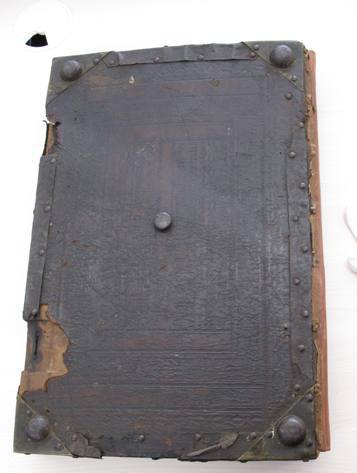Auckland, St John’s College MS 1 (Margaret M. Manion, Vera F. Vines, and Christopher de Hamel, Medieval and Renaissance Manuscripts in New Zealand Collections (Melbourne, London and New York: Thames and Hudson, 1989), no. 49), Bible, Germany, fourteenth century.[1]
This is the binding and part of the text of the so-called Bischewo Bible, acquired by A. W. Reed around 1925. It is in a modern binding structure, but on this has been “mounted” the old, late fifteenth- or sixteenth-century boards that formed one of its early bindings. These boards are covered in tanned calf (once a rich dark brown, but blackened over time). The cover has been extensively tooled. The decoration is described in detail by Manion, Vines, and de Hamel: the binder used panels, stamps, rolls, and “fillets” (roll tools used to create decorative rules). Images of Adam and Eve, the crucifixion, and the brazen serpent are matched by words “PER ADAM MORS”, “PER CHRIST. VITA”, and “NUM. 21”.
We can add detail to Manion, Vines, and de Hamel’s description of the “metal fittings” on the book. These are very elaborate. The book had two fastenings, which closed in the German fashion, so that the catch plates appear on the edge of the upper board. Indentations show that there were also anchor plates but these and the straps and hook-clasps they bore are missing. The catch plates have been decorated with a pattern of engraved lines and turned circles. Their mechanism is comparable to that depicted in Szirmai, Figure 9.47 [a]. The book also had brass corner guards and strips of brass forming protective guards all around its edges (some now missing). The corner guards comprise a separate boss attached to a single nail (visible in the case of one guard on the upper board where the boss has come off) mounted on a corner piece made from sheet metal (see Szirmai, Fig. 9.55 [1] and [8]-[9]).
It is of note that the binder nowhere prepared the board for the fastenings or furnishings, and that where these have been lost the cover is decorated. This suggests that the metal fittings were added after the book was bound, and not necessarily by the binder who applied and decorated the cover. Extensive furnishing of this sort was most common for “frequently used works and books to which the public had access”.[2] Also of note are fragments of paper from an early printed book that appears to have been used to reinforce the binding in some way – perhaps as pastedowns. The words that are visible on these fragments are in a “gothic” – textualis — fount.
Thanks for the John Kinder Theological Library, Auckland, for permission to use the photographs, and to Helen Greenwood for her help.
[1] See also Migrations: Medieval Manuscripts in New Zealand, ed. Stephanie Hollis and Alexandra Barratt (Newcastle: Cambridge Scholars, 2007), pp. 18-19, 37-38, 40, and Ian Dougherty, Boots and Books: The Story of New Zealand Publisher, Writer and Long Distance Walker, Alfred Hamish Reed (Dunedin: Otago University Press, 2005), p. 112.
[2] J. A. Szirmai, The Archaeology of Medieval Bookbinding (Farnham: Ashgate, 1999), p. 263.







